Pomelo Fruit: Bali
I was reading an article in the Jakarta Post a while ago about the Bali Polemo fruit. The homestay where I reside when in Bali, Prawita Cottages, has a few of these trees growing in the gardens. The fruit is forever dropping off the trees and Candika gathers them up for a later feast.
True local: The Bali pomelo
Let us enjoy a citrus fruit of true Indonesian origin. It is a rather large fruit sometimes nearly as big as a football. Its name is jeruk Bali or Bali pomelo.

According to some botanical experts though named Bali pomelo the fruit does not originally come from Bali and until now the origin of Bali pomelo is still not precisely known.
Though relatively cheap, Bali pomelo is a popular tree. In Subang, West Java, many farmers have changed from other citrus varieties to Bali pomelo. In other regions, like on the eastern islands, Bali pomelo has grown into its own specific variety, though it is still named Bali pomelo. Other names for the same citrus variety on other islands are for example jeruk delima, citrus pomegranate, jeruk gulung (citrus roll), jeruk lemo-gula, lima kesumba and munte-bangko.
Today the Bali pomelo tree is scattered across the archipelago. From Aceh in the West to Papua in the East one can easily obtain the local Bali pomelo.
The fruit is also known throughout Asia. In China, India, Thailand and the Philippines, for example, Bali pomelo is a popular fruit eaten as is or mixed with other ingredients in a salad. The rather distinctive flavour, not very sweet or sour but rather tart, makes the Bali pomelo an easy-to-mix fruit. It is however seasonal and when in full season many fruit stalls along the roads sell the fruit. In Jakarta you can get three for Rp 10,000 and toward the end of the season four for the same price.
For those not familiar with Bali pomelo the Latin name is Citrus grandis L Osbeck and it comes in two varieties.
The fruit of a tender pinkish color is called jeruk Bali merah (red Bali pomelo) and the other one with the whitish flesh is called jeruk Bali putih (white Bali pomelo). The fruits are equally consumed but the pink one has a sweeter flavor and can be eaten as is whereas the whitish one is mostly mixed with other fruits to make rujak (fruit salad with pungent dressing).
Because of its tartness Bali pomelo is also used to enhance the flavor of meat. One of the fruits it is most often eaten with is the kedondong a tropical seasonal fruit with a yellow greenish skin, thorny pit and sweet sour flavour.
The very simple looking Bali pomelo is also very nutritious. One hundred grams of flesh – which contains 48 calories -contains 0.6 g protein, 0.2 g fat, 23 mg calcium, 27 mg phosphor, 0.5 mg iron and vitamins A, B1 and C.
The skin and the pith of the Bali pomelo can also be made into a syrup. Its skin can be made into a dried sweet and its oil is used to give traditional sweets a citrus aroma. The flowers of the Bali pomelo are said to have medicinal properties.
In regions where Bali pomelo are grown, like East Java,; children anxiously await the dry monsoon to collect the rather thick skins of the Bali pomelo to make mobil gerobak. They cut a large piece into a container and two or four smaller round pieces for the wheels. A long rope is attached and they can imagine themselves driving around the countryside in their trucks!.
– Suryatini N. Ganie